Zotero vs JabRef: Which reference manager is better?
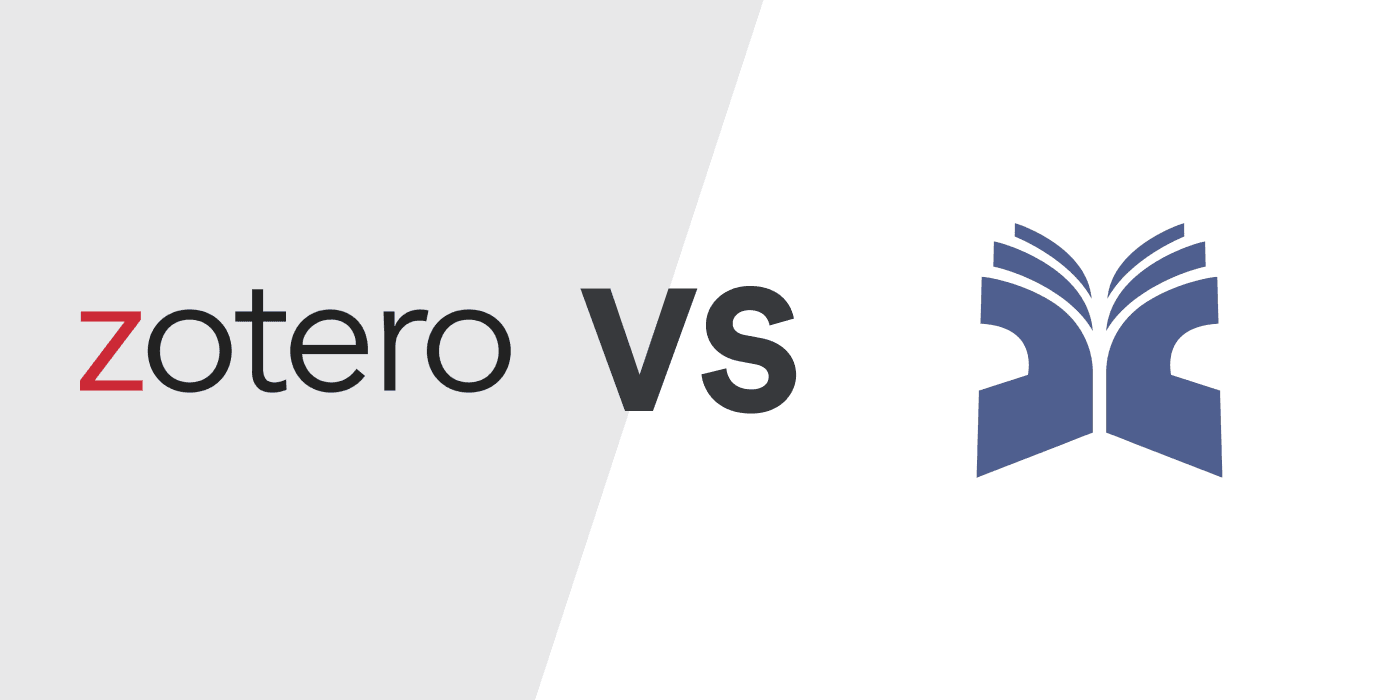
For researchers, identifying a reference manager that integrates smoothly with their work process is crucial for effective organization and citation of literature. However, the plethora of choices can render the task of choosing an appropriate software tool overwhelming.
To ease this process, we will explore two widely-used reference management tools that have LaTeX and BibTeX capabilities: Zotero and JabRef.
Zotero vs JabRef: Detailed feature comparison table
Here's an overview comparing the main features of both tools. Continue reading for an in-depth analysis of the important differences between the two applications.
| Zotero | JabRef | |
|---|---|---|
| Platform Compatibility | 6/7 | 3/7 |
| Web | ||
| iOS | ||
| Android | Third-party apps only | |
| Windows | ||
| MacOS | ||
| Linux | ||
| ChromeOS | Set up Linux terminal | |
| Web clipper | 5/5 | 3/5 |
| Chrome | ||
| Edge | ||
| Safari | ||
| Firefox | ||
| Organize references Add references to folders within extension popup | ||
| Writing Platforms | 4/4 | 0/4 |
| Word on Windows | ||
| Word on Mac | ||
| Google Docs | ||
| Overleaf Live BibTeX integration with Overleaf | ||
| Data Import | 3.5/6 | 4.5/6 |
| Manual import with auto-completion Start typing in a title, URL, or DOI and the reference data will be filled automatically | ||
| Bulk data import Users can upload RIS, BibTeX, NBIB, and PDF files. | ||
| In-app literature search | ||
| Bulk import from web databases | ||
| Metadata extract from PDFs | Incomplete | |
| Create references from identifiers Generate references from DOI, PMC ID, arXiv ID, PubMed ID or ISBN | No PMC IDs | |
| Data Export and Backup | 2.5/6 | 3/6 |
| BibTeX Export BibTeX files | ||
| RIS Export RIS files | ||
| Google Drive | ||
| Github | ||
| OneDrive | ||
| Full data export Export all bibliographic data, labels, folders, and PDF files with annotations | PDFs with annotations must be downloaded individually | |
| Sharing and Collaboration | 3/4 | 0/4 |
| Shared folders Integrated sharing that does not require set up of external folders in other cloud storage apps or databases | ||
| Unlimited collaborators No limit on the number of users who can access a shared folder | ||
| Collaborators can add, edit, and remove references | ||
| Share references with sharing link | ||
| PDF management | 2/6 | 1/6 |
| Custom PDF file naming | ||
| Sticky notes | ||
| Highlight annotation | ||
| Freehand drawing | ||
| Custom highlight colors | ||
| Free text annotations Write anywhere directly on pdf | ||
| Library management | 6/10 | 7.5/10 |
| Labels Also called tags | ||
| Folders | ||
| Subfolders | ||
| Starred items Also called favorites. Automatic filtering of important references displayed in UI | ||
| Notes | ||
| Duplicate detection Easily spot duplicates in your library | ||
| Detect incomplete references Automatic filtering of incomplete references | ||
| Auto-update reference metadata Get reference data updates automatically | Gets data via DOI or ISBN but user must copy and paste the updated data into each field | |
| Find full text PDFs | ||
| Bulk editing of references | ||
| Library search | 5/6 | 5/6 |
| Full-text PDF Search Include full text in search | ||
| Exact phrase search Over library (fields and full-text pdfs) | ||
| Author search Search author field | ||
| Notes search Include notes in search | ||
| PDF annotations search Include PDF annotations in your search | ||
| Highlight search terms in search results | ||
| Citing | 3/4 | 0.5/4 |
| Copy citation to clipboard | Limited to 6 styles | |
| Choose citation style (Word, Google Docs) | ||
| Cite from library (Word, Google Docs) | ||
| Cite from online search | ||
| LaTeX Support | 2.5/3 | 3/3 |
| Copy BibTeX to clipboard | ||
| Create custom BibTeX key pattern | Third party plugin needed | |
| BibLaTeX support Export .bib file with BibLaTeX fields | ||
| Support and Community | 1/3 | 1/3 |
| Community forum | ||
| Customer support via in app chat | ||
| Customer support by email | ||
| Pricing | ||
| Free version (e.g., short-one time project) | Up to 300MB cloud storage for PDFs free | Free |
| Academic user subscription price | $120/year for unlimited cloud storage | $0 Desktop only |
What is Zotero?
Zotero is an open source reference management app for research professionals, operated by the Corporation for Digital Scholarship. It can be used with a range of word processors and with LaTeX and Markdown tools.
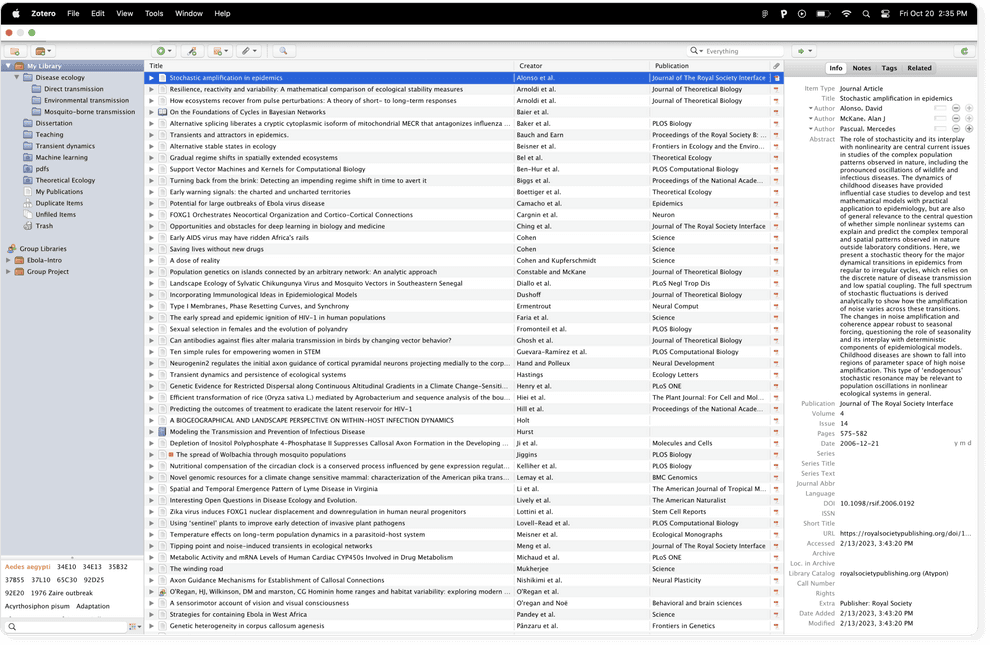
What is JabRef?
JabRef is an open source BibTeX-native citation management tool run by volunteers. It is aimed at academic researchers who write papers with LaTeX.
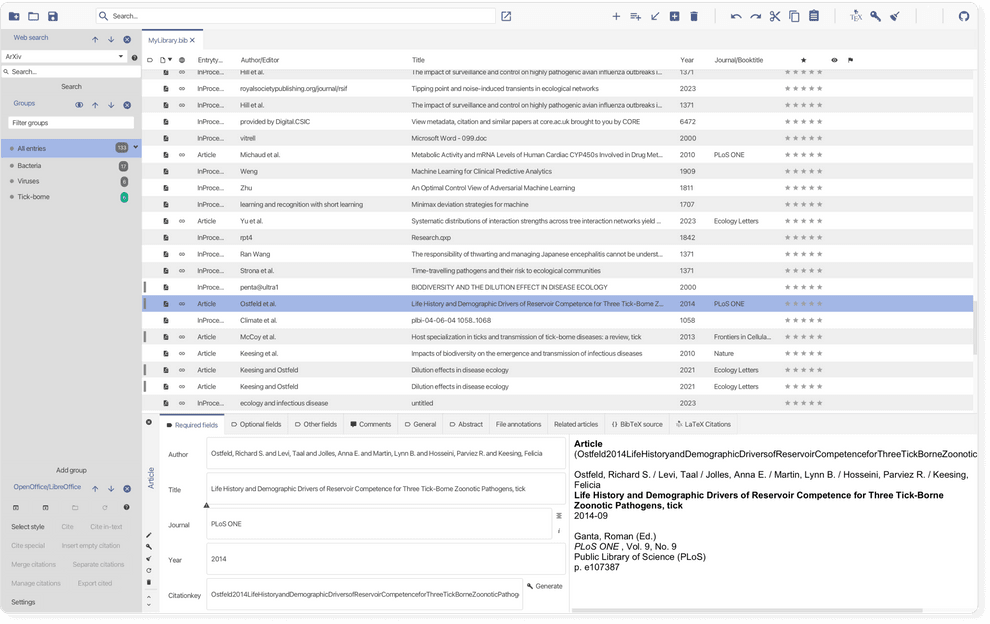
Zotero vs JabRef: 5 factors to consider
When deciding between Zotero and JabRef for creating citations and organizing references, it essentially comes down to several critical considerations.
Cost. JabRef is a free open-source product with no charges for any features. Zotero is also free to download and use, but if you require sync with the cloud for attachments of total size greater than 300MB, you need to pay for cloud storage.
Platform compatibility. Both Zotero and JabRef have desktop apps for Windows, MacOS, and Linux. Zotero has a limited feature web app and it comes with mobile apps for iOS and third party mobile apps for Android. JabRef, on the other hand, is available for desktop computers only.
In-built PDF viewer. Zotero has a PDF reader where you can annotate PDFs. JabRef doesn’t have a PDF viewer—you must use an external app to view and annotate PDFs.
Cloud storage needs. Zotero offers cloud storage for your attachments. Costs start at $20 per year for up to 2GB and it costs $120 per year for unlimited storage. In contrast, as a desktop app, JabRef doesn’t have cloud storage functionality and it is designed to work with desktop LaTeX editors.
Word processor and text editor integrations. Zotero has plugins for Word, Google Docs and LibreOffice, and it supports thousands of citation styles via the Zotero style repository. Zotero also integrates with the Overleaf LaTeX platform. JabRef, on the other hand, has Open Office integration and you can send LaTeX citations to many popular desktop LaTeX editors. But if you want to create non-LaTeX citations for export to other applications, JabRef only has 6 inbuilt styles in its entry editor and you must install other citation styles yourself with custom export filters.
Zotero vs JabRef: Zotero is better for PDF management than JabRef
Unlike JabRef, Zotero can manage PDFs and other files as well as reference data. You can:
- Attach PDFs, website snapshots, or other files to bibliographic items and sync them across devices.
- Read and annotate PDFs with Zotero’s inbuilt PDF reader.
- Compare multiple references at once by opening PDFs in new tabs within Zotero.
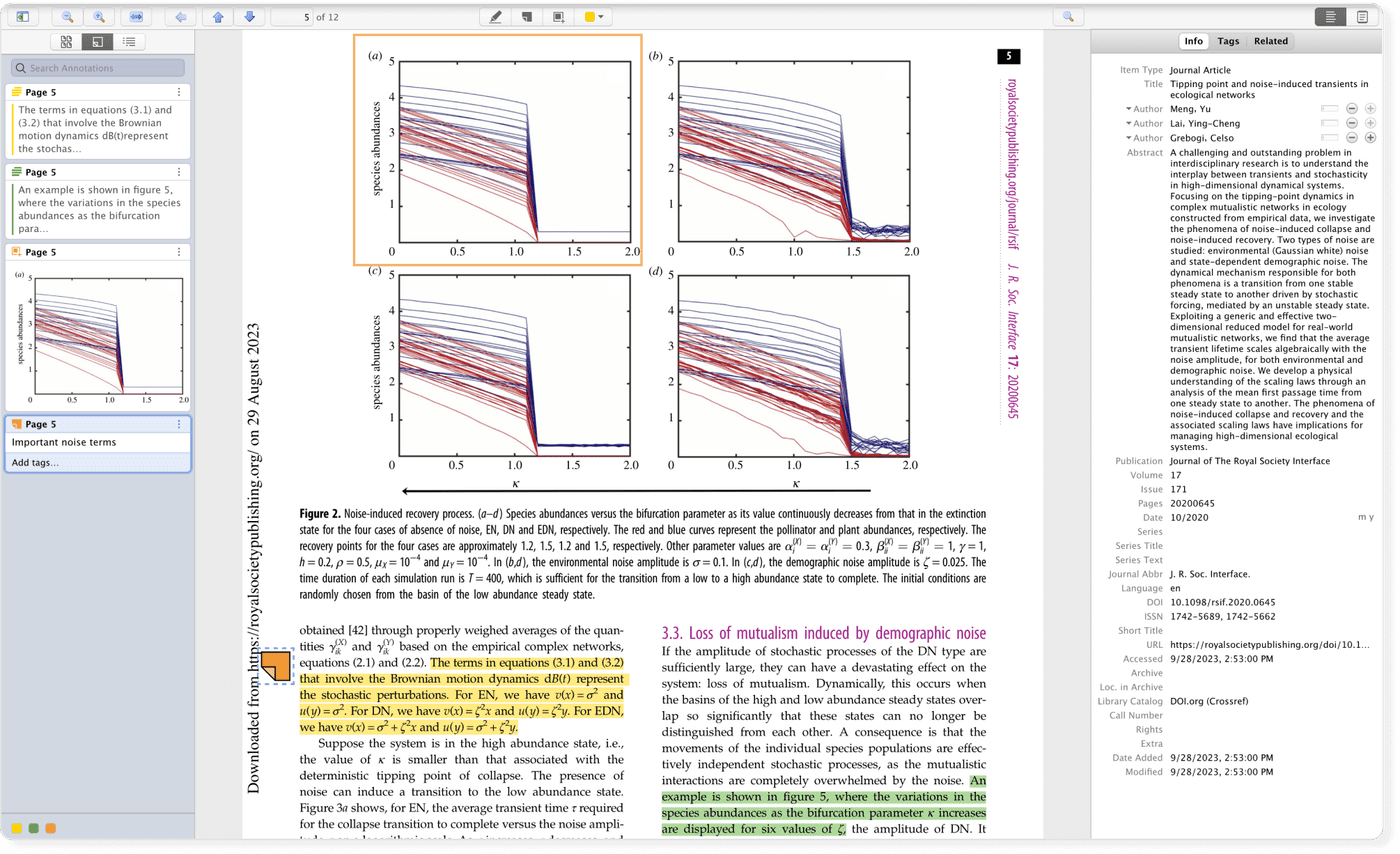
JabRef, on the other hand, helps you manage bibliographic data in BibTeX format only. While it can link to PDFs and other files, you must use an external app to view and and work with your PDFs and attachments, which can create some friction in your workflow as you switch between JabRef and your PDF viewer.

Zotero vs JabRef: JabRef has more convenient inbuilt BibTeX capabilities, particularly for desktop apps
JabRef is a BibTeX-native reference manager, meaning that your references form a database of BibTeX entries and references are not transformed into any other internal file format, which is advantageous if you write exclusively in LaTeX and only use BibTeX or BibLaTeX for reference formatting.
In contrast with JabRef, Zotero’s default BibTeX features are minimal. You can import BibTeX files into Zotero, export references as BibTeX/BibLaTeX, and you can copy BibTeX/BibLaTeX entries via the Quick Copy feature. But you can’t view or change BibTeX citation keys, copy LaTeX citations, or alter citation key patterns out of the box.
To access commonly used LaTeX and BibTeX features in Zotero, you need to download a third-party plugin, Better BibTeX for Zotero, and installing Better BibTeX requires multiple steps.
In the table below we provide a detailed comparison of JabRef’s inbuilt LaTeX and BibTeX features and the functionalities of the Better BibTeX for Zotero plugin:
| Feature | Zotero | JabRef |
|---|---|---|
Display BibTeX key by default in reference information panel | No, requires Better BibTeX plugin | Yes |
Citation key generator | Requires Better BibTeX plugin | Inbuilt, via Library > Library properties and Preferences > Citation key generator |
Flexible pattern generation using field names at specified positions in the key | ||
Update citation key pattern automatically for all references | No, after changing the pattern, select references, right click > Better BibTeX > Refresh BibTeX key | No, after changing the pattern select references, and hit the “Generate citation keys” button |
Duplicate key handling | Yes, starts on second duplicate with letter ‘a’ | Yes, 3 ways to append letters to duplicate keys |
Manually change individual BibTeX keys | Yes, via right click > Better BibTeX > Change BibTeX key | Yes, edit the key in the reference information panel |
Pin keys (fix keys to your own value) | Yes, if you update all keys pinned keys won’t update | No, keys you’ve edited will update to the new pattern |
Copy BibTeX entry | Yes, via Settings > Export > Quick Copy > BibTeX/Better BibTeX, and drag and drop | Yes, via right click > Copy (Command-C keyboard shortcut) |
Copy BibTeX key | Yes, highlight and copy the key from the reference info panel | Yes, via right click > Copy… > Copy citation key |
Copy LaTeX citation | Yes, via Settings > Export > Quick Copy > Better BibTeX Quick Copy: \cite{citation keys}, and drag and drop | Yes, via right click > Copy… > Copy \cite{citation key) (Command-K keyboard shortcut) |
Push LaTeX citations to external editors | TeXstudio via right click > Better BibTeX > Push entries to TeXstudio, other editors you need to set up yourself | TeXstudio, Emacs, Kile/LyX, Vim, WinEdt, and other applications |
JabRef has 6 advantages over Zotero for LaTeX users:
- All of the common LaTeX and BibTeX actions are readily available within the JabRef UI. You can view BibTeX keys in the reference entry information and copy LaTeX citations and BibTeX keys via a right click context menu.
- You can begin to use advanced LaTeX and BibTeX features immediately, like creating your own citation key patterns, instead of having to download a third-party plugin.
- The "Citation key patterns" dialog in JabRef’s Preferences is more user-friendly than the Better BibTeX settings dialog in Zotero because it includes menus covering common use cases. But you need to read about the field markers to understand how to modify the pattern to your liking.
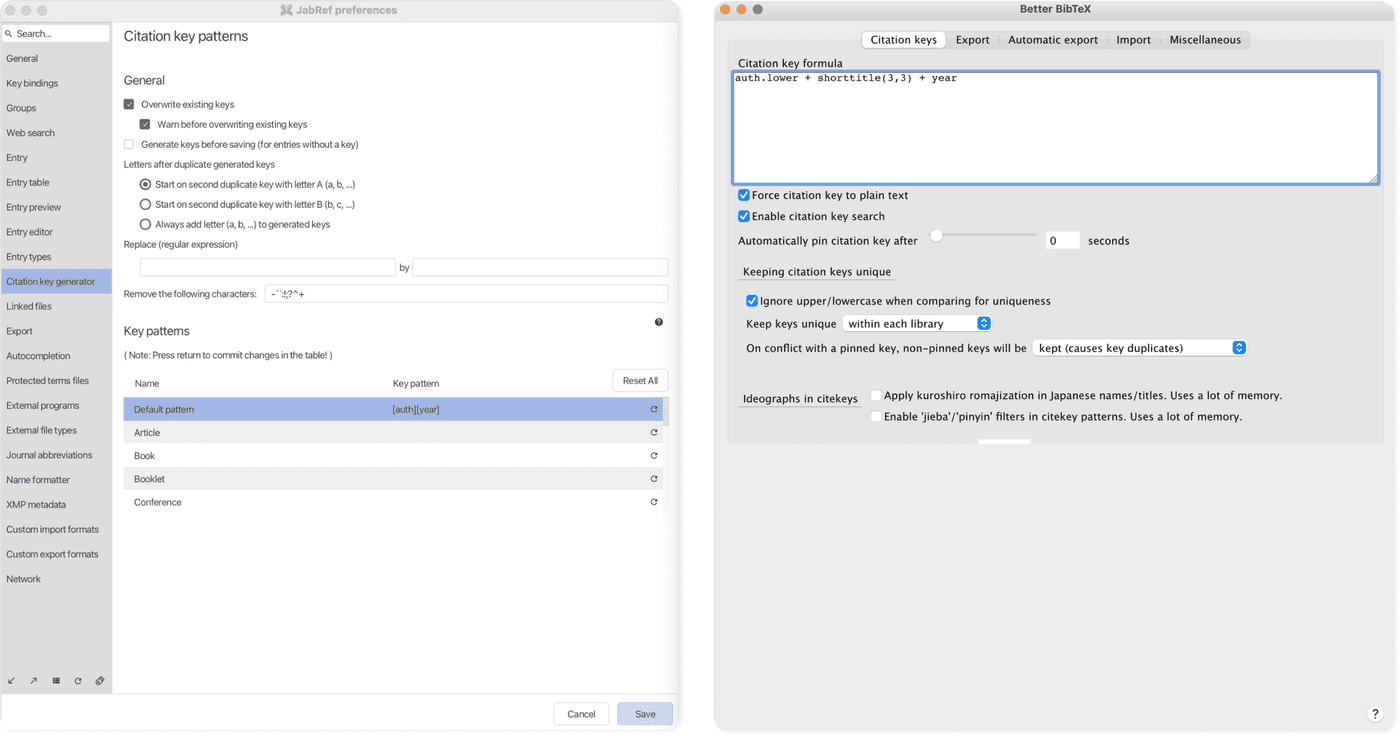
- The default citation key pattern in JabRef is intuitive, producing citation keys with the last name of the first author and the year. In contrast, BetterBibTeX for Zotero follows a longer pattern by default that includes the last name, a short version of the reference title, and the year.
- Duplicate handling is more readily understandable in JabRef than with Zotero’s Better BibTeX plugin. There are three options to handle duplicates by default via a selection menu and the generator removes any unwanted characters.
- Unlike Better BibTeX for Zotero, you can set different key patterns for different reference types in JabRef, e.g., if you wish to differentiate between journal articles vs. conferences proceedings, etc.
In sum, JabRef makes common LaTeX and BibTeX actions faster and easier for LaTeX power users.
Zotero vs JabRef: Sharing reference collections with collaborators is easier in Zotero than JabRef
Both Zotero and JabRef can support collaboration between researchers, but it is easier to set up sharing in Zotero.
Zotero makes sharing easy via the groups feature. A group library is a shared reference collection between researchers. But you need to sign up for a Zotero account before you can create a new group.
Zotero groups have flexible settings and permissions. There are 3 ways that you can set up a group:
- Open public groups: The group page is viewable online by anyone and anyone can join the group. The reference list may be viewable online without joining the group if that setting is applied by the admin but only group members/admins can add new references. Attachments can’t be shared in the group.
- Closed public groups: These have similar settings to open public groups except for two major differences: 1) you can’t join the group without an invitation and 2) there is the option to share attachments with group members.
- Closed private groups: You need to be invited to join and only group members and invited users can view the reference list online. Group members have the option to share and annotate PDFs.
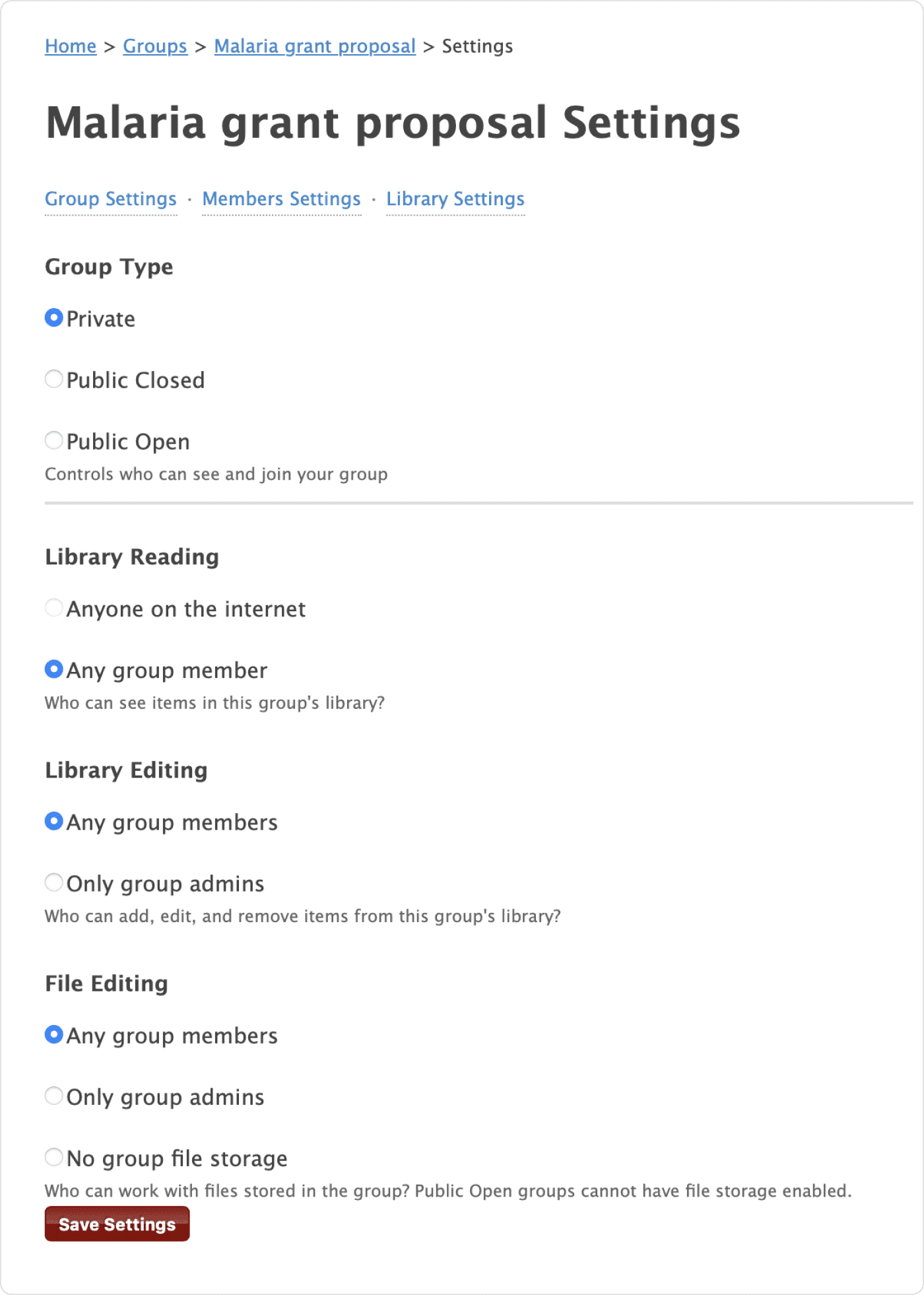
JabRef, on the other hand, supports sharing of SQL databases for collaboration purposes. This has the obvious limitation of needing familiarity with database technologies to use the feature. The easiest way to share a group of references in JabRef with collaborators is to send them in BibTeX format via email.
Zotero vs JabRef: JabRef has some advanced reference management features that Zotero lacks
JabRef has some useful reference management features that Zotero doesn’t have.
File-naming. JabRef allows you to name your PDFs according to the same pattern as your BibTeX keys by going to Preferences > Linked files, selecting the pattern, and hitting “Save”.
After selecting your desired pattern, you can do an automatic clean up of your library to change the attachment names via Quality > Cleanup entries in the JabRef menu, or go to the General tab of a reference item, right-click on the PDF icon and select “Rename file to defined pattern”.
Bulk editing of references. Unlike Zotero, JabRef allows you to edit many references simultaneously.
- You can edit reference types of multiple bibliographic items by right-clicking the selected references in your library, selecting Change entry type > BibTeX and selecting the desired BibTeX entry type (e.g., change “InProceedings” to “Article”).
- You can also edit the content of reference fields by going to Edit > Automatic Field Editor, where you can make edits like changing the title of a journal in a selection of references.
Union and intersection of reference groups. In Zotero and JabRef, you can organize your references into distinct collections using Groups in JabRef and Collections in Zotero. But in JabRef, with the groups toggle on the left hand side of the UI, you can easily view:
- The intersection of groups: References that are shared by more than one group (i.e., show references that are common to two or more groups)
- The union of groups: References that are in at least one group (i.e., show all references in the selected groups).
Automatic reference data updating. You can update references automatically via DOI/ISBN in JabRef by right-clicking on the entry in your library, selecting “Get bibliographic data from DOI/ISBN”, which opens a dialog allowing you to merge your library item with the data obtained from DOI/ISBN information.
- The fields obtained from the original reference are on the left, the fields populated from the DOI/ISBN are shown in the center, and the new merged entry is shown on the right. You can select which fields you wish to keep. If the field is already populated in the original library entry, it is retained (in red), but if you’d like the DOI/ISBN changes, click on the new (green) changes, they will populate the field in the merged entry on the right hand side, and then click the “Merge entries” button to get the newly updated reference in your library.
- You can also get DOIs if missing from a library reference entry by going to Lookup > Search document identifier online > DOI. Then you can update the remainder of the reference via the “Get bibliographic data from DOI/ISBN” feature that opens the “Merge entry with DOI/ISBN” information dialog.
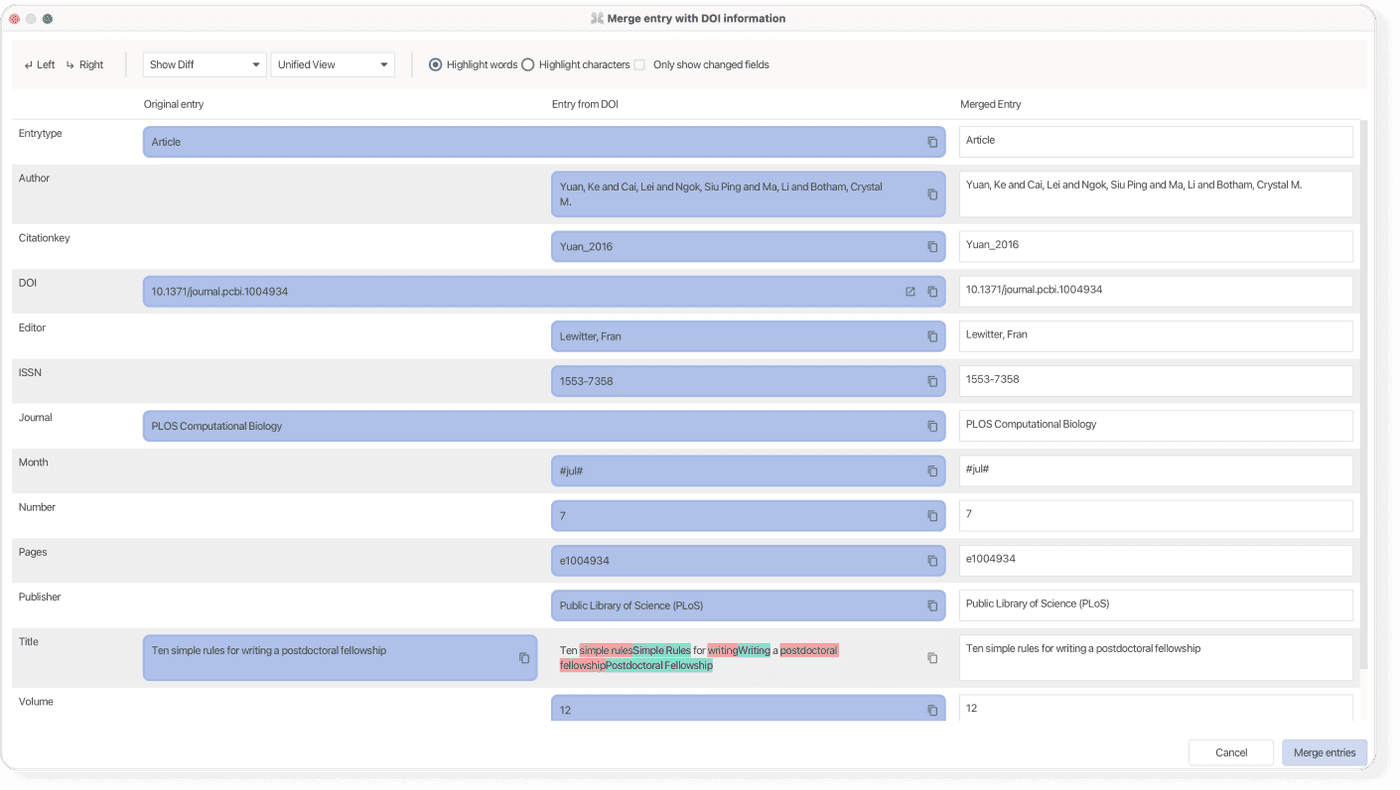
Zotero vs JabRef: Zotero has a better web clipper than JabRef
Zotero’s web clipper, called the Zotero Connector, has many advantages over JabRef’s browser extension.
- It works on all major browsers, including Safari.
- You can import multiple references at once from websites like Google Scholar to your Zotero library.
- You can organize references as you save them by sending them to your collections and tags.
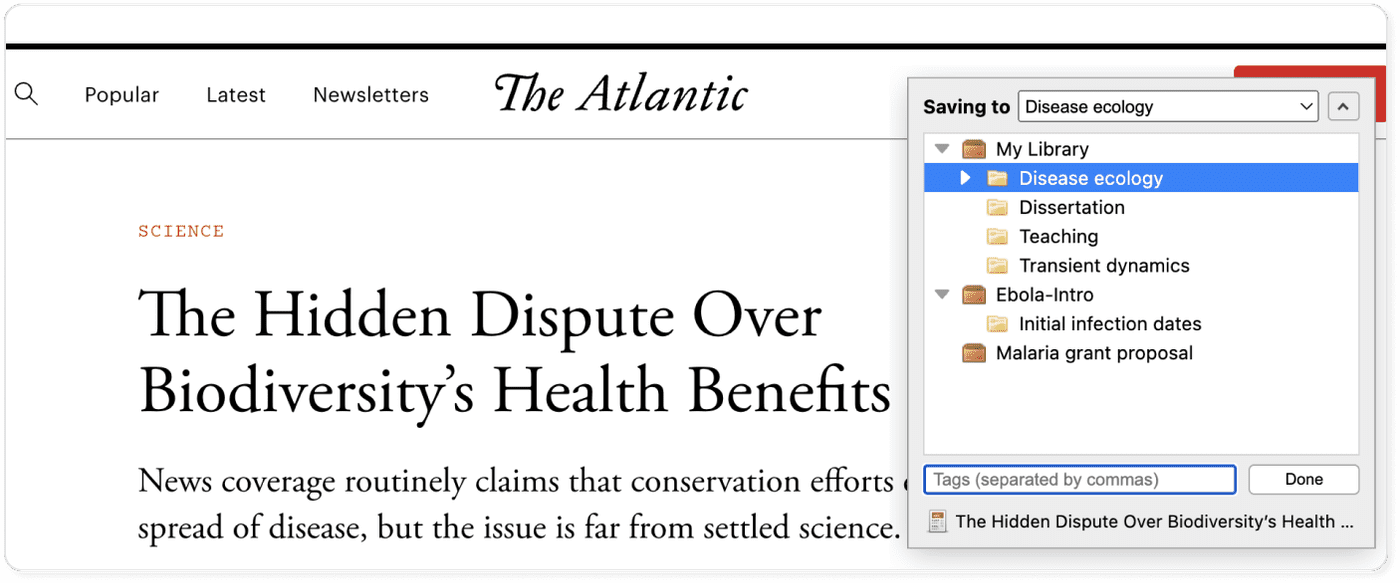
In contrast, JabRef’s browser extension can be tricky to install and it only has basic features. You can only save one reference to your library at a time and you can’t send these to any groups (collections of references in JabRef).
When you click on the JabRef symbol in the address bar, a popup with the message “Sending to JabRef” appears before you are directed to the JabRef desktop app and the Import dialog opens.

Zotero vs JabRef: JabRef has in-app literature search whereas Zotero does not
Unlike Zotero, JabRef has integrated online literature search via a web search box on the left hand side of the UI.

You can save the references you find directly to JabRef by selecting the references you wish to save and clicking the “Import entries” button.

Many of the databases available for web search in JabRef are aimed at STEM researchers, such as MathSciNet and INSPIRE. You can also search major online databases and search engines such as:
- Semantic Scholar
- Medline/PubMed
- Crossref
- arXiv
- IEEEExplore
- ACM Portal.
Zotero vs JabRef: Which is better?
The choice between Zotero and JabRef often depends on the user's specific needs and workflow, particularly regarding their preferences for web integration and browser support versus preferences for LaTeX and BibTeX integration and desktop apps.
Zotero is the better choice if:
- You prefer to use a feature-rich web clipper to collect reference information and attachments
- You prefer to view and annotate PDFs within the app and keep all your notes in one place
- You want to share papers with your collaborators without setting up an external database.
- You need access to a wide range of citation styles and integration with word processors like MS Word and Google Docs, especially if your collaborators don’t use LaTeX.
JabRef is the better choice if:
- You need in-built and extensive LaTeX and BibTeX features that you can use immediately
- You search STEM databases regularly in your research
- You prefer to use a free desktop app, work primarly in desktop editors (do your work primarily on desktop, not cloud-based apps) and you don’t need to back up your database in cloud storage
- You frequently update reference information.
The best way to find which one suits your research workflow best is to give both a try.
Related reading
⇨ How to import your Zotero library to Paperpile
⇨ How to import data from any reference manager via BibTeX or RIS files